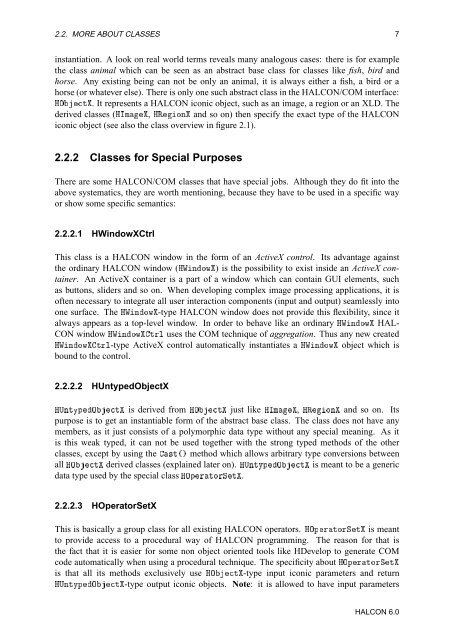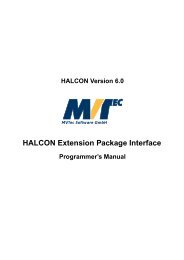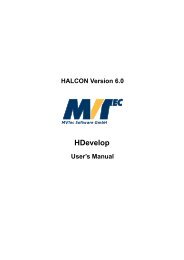HALCON/COM User's Manual
HALCON/COM User's Manual
HALCON/COM User's Manual
Create successful ePaper yourself
Turn your PDF publications into a flip-book with our unique Google optimized e-Paper software.
2.2. MORE ABOUT CLASSES 7<br />
instantiation. A look on real world terms reveals many analogous cases: there is for example<br />
the class animal which can be seen as an abstract base class for classes like fish, bird and<br />
horse. Any existing being can not be only an animal, it is always either a fish, a bird or a<br />
horse (or whatever else). There is only one such abstract class in the <strong>HALCON</strong>/<strong>COM</strong> interface:<br />
ÀÇØ. It represents a <strong>HALCON</strong> iconic object, such as an image, a region or an XLD. The<br />
derived classes (ÀÁÑ, ÀÊÓÒ and so on) then specify the exact type of the <strong>HALCON</strong><br />
iconic object (see also the class overview in figure 2.1).<br />
2.2.2 Classes for Special Purposes<br />
There are some <strong>HALCON</strong>/<strong>COM</strong> classes that have special jobs. Although they do fit into the<br />
above systematics, they are worth mentioning, because they have to be used in a specific way<br />
or show some specific semantics:<br />
2.2.2.1 HWindowXCtrl<br />
This class is a <strong>HALCON</strong> window in the form of an ActiveX control. Its advantage against<br />
the ordinary <strong>HALCON</strong> window (ÀÏÒÓÛ) is the possibility to exist inside an ActiveX container.<br />
An ActiveX container is a part of a window which can contain GUI elements, such<br />
as buttons, sliders and so on. When developing complex image processing applications, it is<br />
often necessary to integrate all user interaction components (input and output) seamlessly into<br />
one surface. The ÀÏÒÓÛ-type <strong>HALCON</strong> window does not provide this flexibility, since it<br />
always appears as a top-level window. In order to behave like an ordinary ÀÏÒÓÛ HAL-<br />
CON window ÀÏÒÓÛØÖÐ uses the <strong>COM</strong> technique of aggregation. Thus any new created<br />
ÀÏÒÓÛØÖÐ-type ActiveX control automatically instantiates a ÀÏÒÓÛ object which is<br />
bound to the control.<br />
2.2.2.2 HUntypedObjectX<br />
ÀÍÒØÝÔÇØ is derived from ÀÇØ just like ÀÁÑ, ÀÊÓÒ and so on. Its<br />
purpose is to get an instantiable form of the abstract base class. The class does not have any<br />
members, as it just consists of a polymorphic data type without any special meaning. As it<br />
is this weak typed, it can not be used together with the strong typed methods of the other<br />
classes, except by using the ×Ø´µ method which allows arbitrary type conversions between<br />
all ÀÇØ derived classes (explained later on). ÀÍÒØÝÔÇØ is meant to be a generic<br />
data type used by the special class ÀÇÔÖØÓÖËØ.<br />
2.2.2.3 HOperatorSetX<br />
This is basically a group class for all existing <strong>HALCON</strong> operators. ÀÇÔÖØÓÖËØ is meant<br />
to provide access to a procedural way of <strong>HALCON</strong> programming. The reason for that is<br />
the fact that it is easier for some non object oriented tools like HDevelop to generate <strong>COM</strong><br />
code automatically when using a procedural technique. The specificity about ÀÇÔÖØÓÖËØ<br />
is that all its methods exclusively use ÀÇØ-type input iconic parameters and return<br />
ÀÍÒØÝÔÇØ-type output iconic objects. Note: it is allowed to have input parameters<br />
<strong>HALCON</strong> 6.0
















